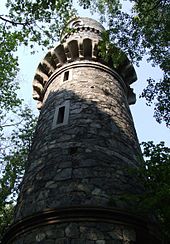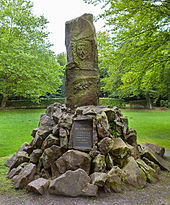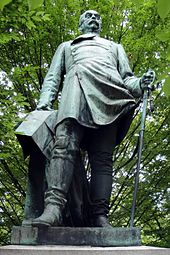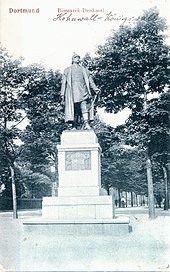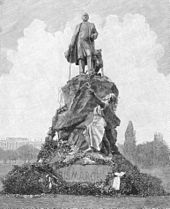Bismarck Monument
Bismarck monuments have been erected since 1868 in honor of the longstanding Prussian Prime Minister and first German Chancellor, Otto Fürst von Bismarck, in many places in Germany at that time (today partly Denmark , France , Poland and Russia ), in former colonies and on other continents.


history
meaning
The Bismarck monuments were the most visible and permanent expression of Bismarck worship or the Bismarck cult in the Empire. The size and complexity of the realized monuments range from memorial plaques to extensive complexes with several groups of figures such as the Bismarck National Monument in Berlin. The flood of Bismarck monuments of all kinds was the third major wave of monuments of the German Empire after the war memorials and victory monuments for the so-called " Wars of Unification " of 1864, 1866 and 1870/71 and the Kaiser Wilhelm monuments .
Bismarck monuments were often directed “against the theatrical power pathos of Wilhelminism”, says Thomas Nipperdey . Unlike the Kaiser Wilhelm monuments, they were often initiated from below.
Monuments before 1871
Even before the founding of the empire , at the time of the North German Confederation , monuments were erected in honor of Bismarck. The first Bismarck monument, a 12 m high obelisk with a marble portrait relief of Bismarck, was a private donation of the Count of Limburg-Stirum since it was unveiled on July 5, 1868 on his estate in Groß Peterwitz in Silesia. A year later, a Bismarck tower was inaugurated as a lookout tower in Ober-Johnsdorf in Silesia. Both monuments were created on the basis of private initiatives.
Monuments 1871 to 1890


Shortly after the founding of the empire in 1871, Bismarck became a monument. Often Bismarck was not only honored with a memorial, but together with other people involved in the wars of 1866 and 1870/71 and the founding of the empire, such as Wilhelm I , Crown Prince Friedrich , Moltke and Roon, in the pictorial program of the victories erected in many places after 1871. or monuments to the founding of the empire included.
The first public Bismarck statues were created from 1877 (portrait relief on the Canossa column near Bad Harzburg). The first monument to show Bismarck in full size was the Bismarck monument erected in Bad Kissingen ( Hausen district ) in 1877 . Initially, the most common ones were bronze busts or statues . Most of them showed the larger than life cast figure of Bismarck as a soldier in a cuirassier uniform on a high plinth, based on the model of the second Bismarck statue, unveiled in Cologne in 1879. These monuments were usually used to decorate central squares of cities. In addition, over thirty Bismarck fountains were built. Bismarck monuments were erected on all continents, mostly in the German colonies, but also in countries with German emigrants such as the USA and Brazil.
Monuments 1890 to 1898
Immediately after Bismarck's dismissal in 1890, committees were set up in several places to plan the erection of representative monuments. The number of memorials now gradually increased. At the same time, new monument forms were designed. Few monuments show Bismarck as a private person such as B. the Leipzig Bismarck Monument , which depicted him as a hunter with his dog Tyras .
Bismarck towers in the medieval style were built more and more instead of the conventional busts or statues . In contrast to the figurative monuments, these were erected on elevated points outside of town.
Monuments and Bismarck Towers after 1898
After his death in 1898, Bismarck's already enormous popularity increased again and with it the number of monument projects. The year 1898 also marked a turning point in terms of design. The figure of Bismarck was depicted several times in a medieval-style armor instead of the traditional costume. The formal language of the monuments became much more archaic and a lot more architectural monuments were built.
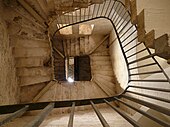
In 1899 (one year after Bismarck's death) the architect Wilhelm Kreis created a basic sample design “Götterdämmerung” in the form of a massive column of fire for a competition of the “German Student Union” , which was awarded 1st prize by the jury. This sample design was executed 47 times with individual differences up to 1911 and thus comes close to a type construction . In many places, however, a building based on this standard design was rejected. Regardless of the architectural design, according to the idea of the student body, fire bowls should be installed on all Bismarckian columns on the tower head, which should burn on certain days in honor of the former Reich Chancellor - like a network throughout Germany. Lighting devices for different fuels were actually installed on 167 Bismarck towers. Since it was not possible to agree on a common day of fire (Bismarck's birthday on April 1st was during the semester break ), this network idea did not prevail. The Bismarckian columns were mostly financed by donations (mainly from the middle classes). Rock from the surrounding area (e.g. granite or sandstone ) should be used as building material . A total of 240 Bismarck towers were erected as observation towers or fire pillars.
The crowning highlight of all Bismarck monuments was actually supposed to be the so-called Bismarck National Monument on the Elisenhöhe near Bingerbrück , which was to be inaugurated on April 1, 1915 on the occasion of the centenary . Planning had been in progress since 1907, and a general competition was held in 1910. However, due to the escalating, highly controversial discussions about the outcome of the competition and the outbreak of the First World War , the project was never carried out.
Many of the Bismarck monuments did not survive the Second World War and the subsequent political changes; they were melted down for armaments production, destroyed in bombings or removed after 1945. Today there are associations in many places that maintain the existing Bismarck towers and columns or collect funds for renovation.
Examples
Equestrian statue of Bismarck next to the Bremen Cathedral
Dresden : Ceremonial unveiling of the Bismarck monument in 1903 (1946–1947 destroyed and demolished)
Bismarck monument in Heilbronn
Bismarck monument in Lübeck
The Bismarck statue in
Bad KissingenThe Bismarck monument in the Nerotalanlagen , Wiesbaden
Unveiled equestrian statue of Bismarck on Wöhrder Wiese in Nuremberg , 1915
The 2015 Bismarck Monument (Wilhelmshaven)
Bismarck monument in Bad Bentheim
Preserved monuments
Statues, busts, memorial plaques
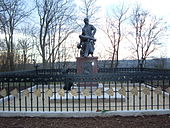

- Aschberg near Ascheffel - statue from Knivsberg / North Schleswig , at the panoramic restaurant
- Baden-Baden - at the Rathausplatz
- Bad Bentheim - sandstone statue on Bismarckplatz, named after him, below Bentheim Castle
- Bad Harzburg - Canossa column on the large castle hill
- Bad Kissingen - statue at the Lower Saline
- Bad Kösen - at the Rudelsburg - the only Jung Bismarck monument , created in 1896 by Norbert Pfretzschner , showed Bismarck unusually casual as a Göttingen student of the Corps Hannovera Göttingen with his dog Ariel . The statue was lost after 1945; the base has been renovated and the replica of the statue was unveiled on April 1, 2006.
- Bad Pyrmont - portrait on the war memorial 1870–71 by Friedrich Volke on Kaiserplatz, 1897
- Bad Schwartau - Groß Parin - memorial stone with the inscription "BISMARCK" and "1895" in front of the "Bismarck oak" planted in 1895.
- Bad Urach - Bismarck bust on a pedestal next to the collegiate church St. Amandus - in front of an oak
-
Berlin
- Big Star - The Bismarck National Monument was created by Reinhold Begas from 1896 to 1901 . The original location was the square in front of the Reichstag building , and in 1938 it was moved to the Großer Stern.
- Bust for the Alte Nationalgalerie by Adolf von Donndorf
- Bismarckplatz in Berlin-Grunewald , statue of Bismarck in civilian clothes with a dog, by Max Klein in 1895 (melted down in 1944, replaced by refill)
- Former Siegesallee , bust as a minor figure to monument group 32 with the central statue of Wilhelm I , unveiled: March 30, 1901.
- Bismarck bust by Reinhold Begas , Kronprinzessinnenweg, Berlin-Wannsee
- Bielefeld - statue in front of the former Chamber of Crafts
- Bremen - Bismarck monument , equestrian statue next to the Bremen Cathedral - design by Adolf von Hildebrand , unveiled in 1910
- Borsfleth - memorial plaque on the Bismarck oak; Inscription: Bismarck Oak April 1, 1895 Location
- Bühl - memorial stone on the sand
- Burg (Spreewald) - The Bismarck Tower is a Bismarck monument on the Schlossberg north of the municipality of Burg (Spreewald), the 28 m high structure was erected from 1915 to 1917.
- Darmstadt - Bismarck fountain on Ludwigsplatz
- Detmold - on the forecourt of the Hermann monument
- Döbeln - Bismarck monument on the Obermarkt; unveiled July 5, 1905
- Donaustauf - Bismarck bust in the Walhalla; unveiled October 18, 1908
-
Dortmund
- Syburg district (Hohensyburg) - statue of Adolf von Donndorf as an assistant figure at the Kaiser Wilhelm monument
- Marten district - bust monument by Arnold Künne on Martener Straße
- Dresden - Relief on Körnerplatz on the building of the café (from 1894)
- Duisburg - near the town hall
- Düren - Bismarck monument on Bismarckstrasse / Theodor-Heuss-Park
- Düsseldorf - Bismarck monument in the city center , unveiled on May 10, 1899 on Alleestraße (today Heinrich-Heine-Allee ), since 1961 on the northwest side of Martin-Luther-Platz; Design by August Bauer and Johannes Röttger , statue of 3 m and base in Bayreuth granite of 4 m, in the interim skirt of the Halberstadt cuirassiers with helmet, in the left a saber standing on the ground, left leg in front, looking slightly to the right, to the right of the base Seated male figure with a bare torso and antique helmet, in the right a sword and in the left a bundle of oak sticks, on the left on the base a female figure in a simple floor-length dress with a hammer in the right hand, under the feet a hammer, which is the coat of arms of the base lost during the war-related dismantling of the monument, as were the lower plinth parts
- Eberbach ( Rhein-Neckar-Kreis ) - Bismarckstein with portrait
- Erfurt - Bismarck statue by Christian Paschold at the Bismarck house on the Erfurt Anger
-
eat
- Südviertel - Bismarck monument , 1899 by Reinhold Felderhoff , on the Bismarckplatz in front of the railway headquarters at that time, bronze statue about 3 m high with a simple military skirt and pickled cap , on a base (1.50 m)
- Kettwig district - south side of Martin-Luther-Platz (formerly Hauptstrasse), group of three with Wilhelm I and Roon : Kaiser Wilhelm and his victorious heroes
- Werden district - at Dückerpark, next to Kaiser Wilhelm and Helmuth von Moltke
- Feldberg in the Black Forest - summit of the Seebuck
-
Frankfurt am Main
- Höchst district - east of the industrial park
- Gadebusch - boulder with relief, lost today
- Goslar - on the Georgwall promenade by sculptor Willibald Böttcher , unveiled in 1902
- Guteborn - Boulder with a stone tablet on the main road, Dorfaue, erected on April 1, 1915
-
Hamburg
- Neustadt - in the old Elbpark above the harbor. The stone statue of the Bismarck monument in Hamburg is the largest of all Bismarck monuments.
- Altona-Altstadt - green area on Königstrasse, bronze statue on a base by Adolf Brütt , 1898 (see other Bismarck monuments in Hamburg )
- Bergedorf - in the park of Bergedorfer Castle , bronze relief on a granite slab resting on three granite columns, 1906 (see other Bismarck monuments in Hamburg ).
- Hamburg-Altstadt - statue on the facade of the Laeiszhof, together with Kaiser Wilhelm I , Albrecht von Roon and Helmuth von Moltke , by Bruno Kruse , 1897/98
- Hanau Wilhelmsbad - across from the park
- Hann. Münden - bust in the ramparts, 1895
- Heidelberg - at Bismarckplatz
- Heidenheim an der Brenz - memorial stone with relief in the station facilities
- Heilbronn - statue in Bismarckpark
- Husby - near Flensburg, Schleswig-Flensburg district - memorial with relief medallion from 1900
- Itzehoe - Originally Sude, after the incorporation in 1911 a district of Itzehoe. Commemorative plaque for April 1, 1895 (80th birthday). Itzehoe now has both a memorial plaque and a Bismarckian column. Location
- Jena - relief by Adolf von Hildebrand at the Bismarckbrunnen (market)
- Karlsruhe - at the Bismarck High School
- Kiel - statue in Hiroshimapark by Harro Magnussen (1897)
- Krefeld - Bismarckviertel district on Bismarckplatz, empty plinth with inscription, the statue is to be re-cast according to rediscovered original forms.
- Landstuhl (Kaiserslautern district) - Bismarck tower on the Kirchberg
- Langerwehe ( Düren district ) - Bismarck monument in the Kammerbusch landscape garden
- Lienen ( Steinfurt district ) - Bismarckstein with portrait
- Lindau (Bodensee) - in the district of Hoyren , about halfway up on the south side of the Hoyerberg, the approx. 10 m high statue "Eagle" with a large Bismarck relief in the base of the platform there
- Lübeck - between the train station and Lindenplatz (1903) by Emil Hundrieser
- Mannheim - between the train station and Schwetzingen suburb by Emil Hundrieser (1900)
-
Munich
- at the Deutsches Museum at the Boschbrücke by Fritz Behn (1931)
- one of the relief medallions on the corner pillars at the base of the Angel of Peace , 1896/99
- North (East Frisia) - At the market
- Nuremberg - Prinzregentenufer
- Pforzheim - in the city garden
- Pinneberg boulder with bronze relief in Fahltskamp near Pinneberg train station
- Sohland on the Spree - memorial stone on Schluckenauer Strasse
- Teterow - memorial stone with bronze relief (relief renewed after 1990)
- Wiesbaden - Nerotal plant : statue from 1898, later moved here from the city
- Worms - Bismarck Memorial (Worms) : in the park of after storage for about 1,950 in 2015 Kunsthaus Heylshof set
- Wuppertal - Barmen - statue at Geschwister-Scholl-Platz , Bismarck monument (Barmen)
- Zweibrücken - Herzogvorstadt district: statue at the town hall, erected by Wilhelm Albermann , 1894
Abroad
- Buea (Cameroon) - Bismarck Fountain, 1897, with picture medallion
Bismarck Towers
Not preserved monuments

Statues, busts, memorial plaques
Brazil
- Porto Alegre , built in 1902 on the site of the former rifle club, the bust disappeared during the Second World War, the sandstone base is now on the site of the “Clube dos Caxeiro Viajantes”.
Hesse
- Frankfurt am Main , created by Rudolf Siemering , set up in the Gallusanlage in front of the Schauspielhaus in 1908, melted down in 1940 for the metal donation of the German people .
Brandenburg
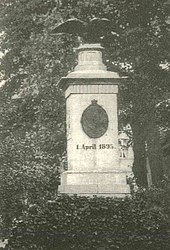
- Ruhland , 1895 dedicated to Otto von Bismarck on his 80th birthday by the Ruhland homeland association; Across from the upper parish on the church square, an oak was planted in April and a 2 ½ m high monument made of sandstone was inaugurated on June 9th . The front of the memorial had a plaque with the portrait and the inscription “1. April 1895 ". On the back it said "The Great Chancellor". The memorial was removed in 1945.
Mecklenburg-Western Pomerania
- Grevesmühlen , boulder with relief
- Neubrandenburg , 1895, boulder with relief and bronze eagle on top, destroyed
- Schwerin , Bismarck monument 1901 by Wilhelm Wandschneider , dismantled and melted down around 1950
- Warnemünde , 1907, boulder with inscription removed (after) 1945 inscription, foundling in 1969 in the foundation of the Hotel "Neptun" installed
Lower Saxony
- Wilhelmshaven - bronze statue, 1905 by Georg Meyer-Steglitz , destroyed in World War II; It was rebuilt on April 24, 2015 in a modified version.
North Rhine-Westphalia
- Altena - bronze statue unveiled on September 1, 1895 on Lüdenscheider Strasse, made by sculptor Arnold Künne , donated by Gustav Selve , dismantled during World War II
- Dortmund - Monument on the Südwall with a statue of Wilhelm Wandschneider , inaugurated in 1903, dismantled during World War II, found irreparably damaged at the end of the 1950s and melted down
- Herdecke - erected in 1902 by a “citizens' initiative”, bronze bust based on a model by Friedrich Reusch , added to the non-ferrous metal collection during the Second World War; The base of the monument was removed in 1946 and the street was renamed Goethestrasse by resolution of the city council from Bismarckstrasse.
- Hilden - Fountain with a bronze bust of Wilhelm Albermann , inaugurated in 1899, demolished in 1942
- Cologne - Bismarck memorial , unveiled on Augustinerplatz in 1879, stolen after 1945
- Vlotho
- Wuppertal , Barmen district , Bismarck monument 1900 by Hugo Lederer , formerly erected in front of the old Barmer town hall, moved next to the Barmer Hall of Fame in 1921
- Wuppertal, Elberfeld district , Bismarck monument with a statue of Ludwig Brunow in 1898 , dismantled and melted down in 1942
Saxony
- Dresden - Bismarck memorial by Robert Diez , unveiled in 1903, demolished in 1946, melted down in 1947
- Großschönau - Bismarck bust in the Kaiserhain on Hutberg , unveiled in 1892, destroyed in 1946
- Freiberg , Bismarck monument, unveiled on September 2, 1895 on Postplatz (1925 to 1945 Bismarckplatz; today Platz der Oktoberopfer ) on the occasion of Bismarck's appointment as an honorary citizen. On July 15, 1942, the bronze monument was removed from its pedestal to make it available for war production. After the Second World War, it was finally melted down in Freiberg. Since July 30, 1998, a bronze plaque commemorates the monument on the site.
-
Leipzig - Bismarck monument in civilian clothes as a hunter with the Reich dog , the mastiff Tyras II , and an allegorical figure symbolizing him as the “blacksmith of unity”, by Adolf Lehnert and Josef Mágr , removed from the southern tip of Johannapark since 1897 , 1946 .
In 1915, the design of a second Bismarck monument by Carl Seffner stood in front of the New Town Hall for about 14 days . - Sebnitz - Bismarck monument made of bronze by Victor Seifert , inaugurated around 1903, destroyed in 1946
- Zwickau - Bismarck monument made of bronze by Josef Drischler on a granite base, inaugurated on April 1, 1898, on Kaiser-Wilhelm-Platz (today Schumannplatz); Height of the figure 2.80 m and of the whole monument 5.60 m; The statue is said to have been melted down in 1943.
Saxony-Anhalt
- Halle (Saale) - Monument with a statue on Bergschenkenfelsen in the district of Kröllwitz; by sculptor Paul Juckoff ; dismantled before 1933
- Magdeburg - larger than life statue on today's Friedensplatz; melted down
- Wernigerode - larger than life statue on the Harburg; Demolished in 1953
Schleswig-Holstein
- Flensburg - Bismarck fountain by Helmuth Schievelkamp on Südermarkt , unveiled on April 1, 1903, dismantled in 1937
- Elmshorn - Bismarck memorial in front of the Bismarck School , erected on April 1, 1903, melted down in 1943
Thuringia
- Arnstadt - Bismarck fountain on the market square, 1909 based on a design by Georg Wrba , bronze parts dismantled and stored as a work of art worthy of protection during the Second World War, permanent fountain basin removed after 1950, reconstruction with preserved parts in a warehouse since 2006, public re-installation refused
- Eisenach - Bismarck monument by Adolf von Donndorf , erected in 1903 at the entrance to the city park , removed until 1963 ( picture )
- Gotha - Bismarck monument on the corner of Bahnhofstrasse and Ohrdrufer Strasse (today Mozartstrasse) by Johannes Schilling , inaugurated on March 31, 1901, melted down during World War II, the Seeberg sandstone base has been preserved in its original location to this day
- Nordhausen - Bismarck monument in the "Promenade" park, inaugurated in 1900, removed at the end of 1945
Poland
- Breslau (Silesia) - statue by sculptor Peter Breuer , 1900 on the former Königsplatz, removed after 1945 See also: Bismarck Monument (Breslau)
- Oleśnica , until 1945 Oels (Silesia) - statue by Robert Baerwald , melted down in 1944
- Opole , until 1945: Opole ( Upper Silesia ) - 1911 by sculptor Robert Bednorz , located on the station square, 1945
- Poznan - Bismarck Monument unveiled in 1903, removed in 1919
Russia
- Kaliningrad, formerly Königsberg - Bismarck monument , 1901 by Friedrich Reusch
See also
literature
- Reinhard Alings: Monument and Nation. The image of the nation state in the monument medium. On the relationship between nation and state in the German Empire, 1871–1918. (= Contributions to the History of Communication , Volume 4.) Berlin / New York 1996.
- Thomas Gräfe: Bismarck Myth and Politics. The mythization and politicization of the worship of Bismarck by the parties and associations of the national camp during the Wilhelmine period 1890–1914. Hamburg 2014, ISBN 978-3-8428-9853-0 .
- Werner Greiling: The Bismarck Tower. Civic engagement and national monument culture. Hain, Weimar / Jena 2003, ISBN 3-89807-045-X . (via the Bismarck Tower in Neustadt an der Orla )
- Hans-Walter Hedinger: Bismarck monuments and Bismarck worship. In: Ekkehard Mai , Stephan Waetzoldt (ed.): Art administration, building and monument policy in the empire. Berlin 1981, pp. 277-314.
- Jörg Koch: Bismarck monuments and Bismarck memorials on the Upper Rhine. Regional culture publisher, Ubstadt-Weiher 2015.
- Kai Krauskopf: Bismarck monuments. A bizarre departure into the modern age. Hamburg 2002, ISBN 3-935549-33-4 .
- Andreas Leutzsch: Bismarck? We get corn from that, and it's good. In: Andreas Leutzsch (Ed.): Nomaden. Interdisciplinary walks in the field of forms and myths. Festschrift for Jürgen Frese. transcript, Bielefeld 2003, ISBN 3-89942-111-6 , pp. 64-88.
- Michael CQ McGuire: Bismarck in Walhalla. The cult of Bismarck and the politics of national identity in Imperial Germany 1890-1915. Ann Arbor 1993.
- Dirk Reinartz, Christian Graf von Krockow: Bismarck. From the betrayal of the monuments. Steidl-Verlag, Göttingen 1998, ISBN 3-88243-175-X . (Photo and text volume on the subject of Bismarck monuments and towers)
- Sieglinde Seele , Günter Kloss: Bismarck Towers and Bismarck Columns. An inventory. Michael Imhof, Petersberg 1997, ISBN 3-932526-10-4 .
- Sieglinde Seele: Lexicon of the Bismarck Monuments . Michael Imhof, Petersberg 2005, ISBN 3-86568-019-4 .
- Jörg Bielefeld, Alfred Büllesbach: Bismarck Towers. Architecture, history, landscape experience. Morisel Verlag, Munich 2014, ISBN 978-3-943915-08-2 .
Web links
- List of Bismarck Tower associations
- Jakob Hort: Bismarck monuments. In: Historical Lexicon of Bavaria . March 25, 2011, accessed April 21, 2012 .
Individual evidence
- ↑ Thomas Nipperdey: German History 1866-1918. Volume II: Power State Before Democracy. Beck, Munich 1992, p. 599 f.
- ^ Illustrated newspaper. No. 1307 of July 18, 1868, p. 51.
- ↑ Max Schmid: One hundred designs from the competition for the Bismarck National Monument on the Elisenhöhe near Bingerbrück-Bingen. Dusseldorf 1911. ( Digitalisat the ULB Dusseldorf )
- ↑ Max Dessoir , Hermann Muthesius : The Bismarck National Monument. A discussion of the competition. Eugen Diederichs, Jena 1912.
- ^ Statues Hither & Dither: Bad Bentheim
- ^ Statues Hither & Dither: Bad Pyrmont
- ^ Statues Hither & Dither: Bielefeld
- ↑ Statues Hither & Dither: Detmold
- ^ Statues Hither & Dither: Eberbach
- ↑ Andreas von Seggern: "... a particularly serious duty, especially for those from Bergedorf ..." On the Bismarck monument in the castle park. In: Lichtwark issue No. 70, HB-Werbung publishing house, Hamburg-Bergedorf 2005, ISSN 1862-3549
- ^ Statues Hither & Dither: Hamburg
- ↑ Statues Hither & Dither: Hann. Münden
- ^ Statues Hither & Dither: Lienen
- ^ Statues Hither & Dither: Munich
- ^ Stadt-München.net
- ↑ Statues Hither & Dither: North
- ↑ www.ffmhist.de
- ↑ Horst Bormann: The Elster Chronicle still knows. . . Ruhland 100 years ago: Bismark oak and Bismarck monument. In: Official Journal Office Ruhland. 6/1995, p. 8.
- ↑ Elster Chronicle. April 1895 and June 1895.
- ↑ bahnhofsvorstadt.de
- ↑ Leipzig Lexicon
- ↑ Sieglinde Seele: Lexicon of Bismarck Monuments. Michael Imhof Verlag, Petersberg 2005, p. 424.
- ↑ Reinhold Brunner: That was the 20th century in Eisenach. Wartberg Verlag, Gudensberg-Gleichen 2000, ISBN 3-86134-970-1 , p. 65.
- ↑ 1895: Reich Chancellor and Prime Minister Otto Fürst von Bismarck
- ↑ Bismarck monument on NordhausenWiki
- ^ Sieglinde Seele: Breslaus Bismarck Monuments. ( Memento from December 29, 2007 in the Internet Archive ) Mannheim / Berlin 2007, on: breslau-wroclaw.de
- ↑ Sieglinde Seele: Lexicon of Bismarck Monuments. Michael Imhof, Petersberg 2005, p. 300.
- ^ Ryszard Emmerling: 100 old postcards from Opole 1897–1938. Adan, Opole, p. 41.
